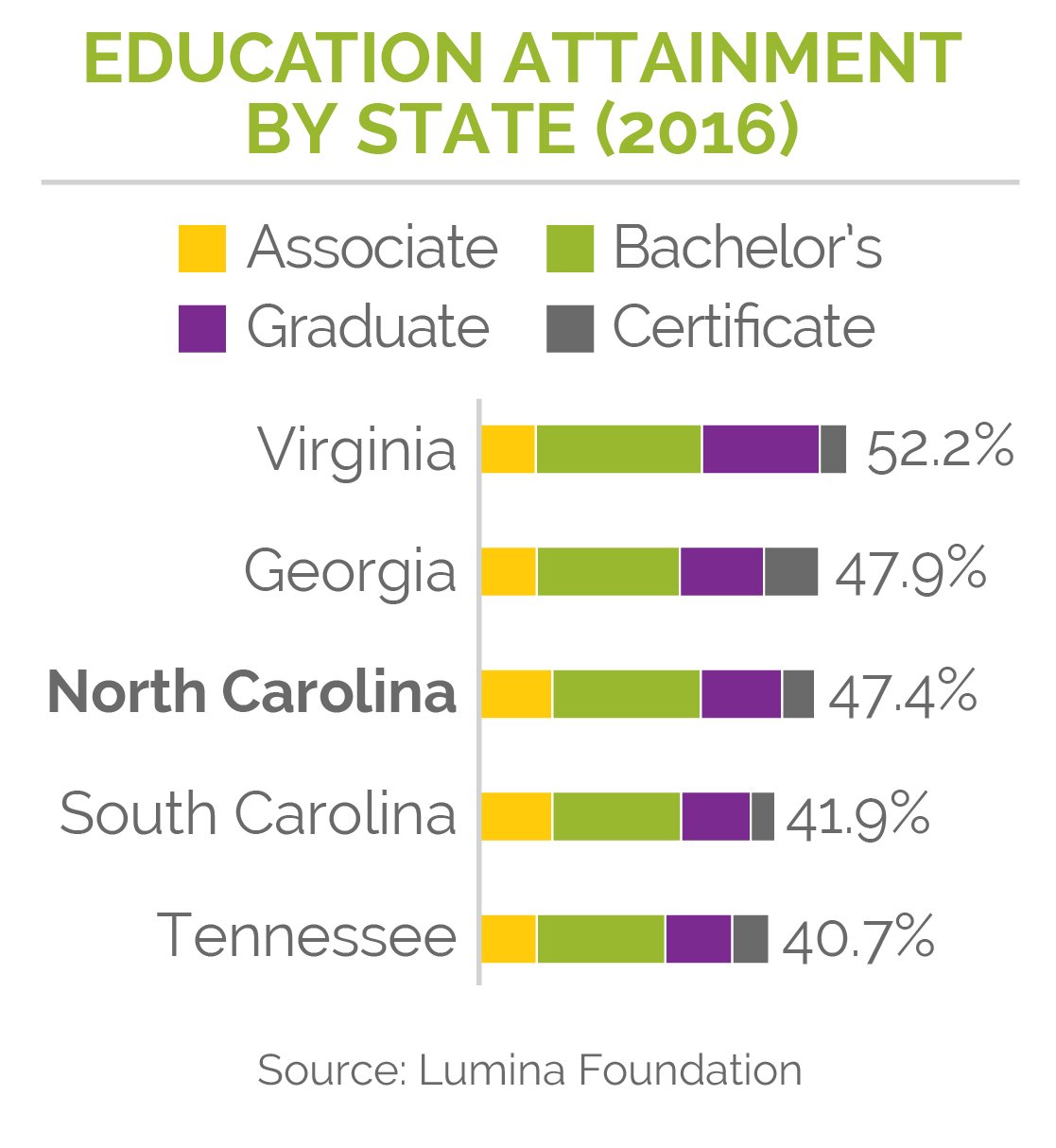CARY – Just how educated are North Carolinians? And how educated do we need to be by 2030?
If we count high-quality credentials, 47.4% of North Carolinians had obtained a degree or credential beyond high school in 20161 – that’s 13 percentage points below the Lumina Foundation’s national goal of 60% attainment by 2025.2
It lags the 52.2% attainment rate in neighboring Virginia, which ranks 6th in the nation, and the 47.9% rate of Georgia, which ranks 20th. But North Carolina is ahead of South Carolina, at 41.9%, and Tennessee, at 40.7%.3
Because 67% of North Carolina jobs will require some form of postsecondary education by 2020,4 the myFutureNC Commission began to zero in on an attainment goal for North Carolina at its meeting Friday at SAS Institute in Cary.
The commission of state education, business, philanthropic, faith-based and nonprofit leaders intends to announce a shared attainment goal by February 2019.5
UNC System President Margaret Spellings noted that Tennessee set a goal of 55% attainment by 2025.
“Tennessee’s ‘Drive to 55’ would be an undershoot for us. We can do better,” Spellings said, suggesting a more “audacious” goal. But Oregon’s goal of 80% attainment would probably be too ambitious, she said.
John Tapogna of ECONorthwest, a Portland, Oregon-based economic planning consultant, told commission members that North Carolina punches above its weight in education, given its socioeconomic status. He noted that the state is a top-10 bet to win Amazon’s HQ2 headquarters.
North Carolina was among the nation’s leaders in education attainment gains from 2006-16, growing 7%, Tapogna said. Still, it would take 15-20 years for the state to close the attainment gap at its current rate. And it faces dramatic gaps by race, he warned.
A “moderate” goal over 10 years would be for North Carolina to add 9%, for 56% attainment, Tapogna said. A “stretch” goal would be to add 11%, for 58% attainment. And an “ambitious” goal would be to add 13%, matching the national Lumina Foundation goal of 60%.
The attainment goal should influence state and local education budgets. “This is an exercise to guide investment across the education continuum,” Tapogna said.
But he also warned the commission not to be overly ambitious, describing Oregon’s 80% attainment goal as a “North Star.”
“There needs to be a stretch here, and you need to move out of your comfort zone,” Tapogna said. “But if you move too far, it becomes questionable.”
PARTICIPANTS IN THE DISCUSSION recognized that each education sector is interconnected with the others. New NC Community College System President Peter Hans noted the “criticality” of community colleges to helping more North Carolinians obtain degrees and credentials.
And David Mounts, CEO of Inmar in Winston-Salem, cited research by the Milken Institute that found the highest returns on investment in education are from early-childhood education. China is investing more heavily than the United States in early-childhood education, Mounts said.
Tapogna agreed. If North Carolina is serious about closing its attainment gap, he said, it will require much more work with students before age 5.
Despite many efforts, achievement gaps have proven difficult to narrow in K-12, he said – the most dramatic gains are made before children reach kindergarten.
Later in the day, a myFutureNC P-12 committee recommended universal pre-kindergarten as a strategy to eventually improve college attainment.
“That has to be a priority within our state,” said Todd Roberts, Chancellor of the NC School of Science and Mathematics and co-chair of the committee.
Jack Cecil of Asheville, co-chair of a committee on workforce needs, stressed that the state must be sensitive to geographic and demographic differences as it seeks to satisfy industry’s demand for workers.
But it also needs to move swiftly, he said, suggesting the state set intermediate attainment goals for 2024.
“We can’t start something de novo, he said. “We need to move quickly.”
1 https://www.myfuturenc.org/wp-content/uploads/2018/06/InfoBrief-EdAttain-Sims.pdf, p. 13.
2 Ibid, p. 1.
3 Ibid, p. 4.
4 https://cew.georgetown.edu/wp-content/uploads/2014/11/Recovery2020.SR_.Web_.pdf, p. 3.
5 https://www.myfuturenc.org/faqs/.




Jesse Vinson says
Your points are valid. Regretfully, changes must occur with the parents before there can be reasonable change. In our County 43% of students receive free or reduced price meals. Some children arrive at school in dirty clothes; they often acknowledge there is no food at home. There must be a cultural shift to convince parents of the value of education to their child’s future. The parents, themselves, must recognize the importance of education and improving one’s station in life. And then, there’s the drug problem………..